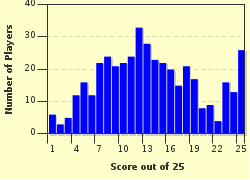Quiz Answer Key and Fun Facts
1. The Romans named the fourth planet from the sun after their god of war. What is the Greek name for Mars?
2. On Christmas Day 2003 Britain attempted to soft land a vehicle on Mars. What was the name given to this landing probe?
3. In 1878 Italian astronomer Giovanni Schiaparelli produced the best map of Mars to date. He is best remembered for his reported assertion that the planet was covered in a network of what?
4. In 1971 two Soviet and one American probe were successfully dispatched to Mars. However by November when they were approaching their destination the planet was totally obscured by which of these?
5. The European Space Agency became the third organisation to place a spacecraft in orbit around Mars when it successfully launched Mars __________?
6. To address concerns about the high cost of planetary missions and their lengthy development time NASA administrator Dan Goldin introduced the concept of ___________ Better Cheaper for development of future missions.
7. In January 2004 two of the most successful missions to date commenced when Spirit and Opportunity landed on Mars to begin their remarkable missions of discovery. Where did Spirit land?
8. Which feature marks the lowest elevation and is the largest recognisable impact crater on Mars?
9. In 2008 cameras from the Phoenix Lander quickly spotted a smooth patch of ground directly beneath the Lander. What was the nature of this patch?
10. For more than forty years the ________ Propulsion Laboratory has been responsible for conducting NASA's exploration of Mars and the rest of the Solar System. What name fills in the gap?
11. The first attempted missions to Mars occurred in October 1960 under the direction of the anonymous 'Chief Designer' of all the early Soviet space programmes. Who was this 'Chief Designer'?
12. When astronomers chose a Prime Meridian for reference when making their maps of Mars they drew it through a region called the Sinus Meridiani. The prime meridian is the first line of which of these?
13. NASA launched a series of missions in the 1960s and early 70s which achieved the first fly-by and became the first artificial orbiting satellite of Mars. What were these missions called?
14. Japan became the third country to send a mission to Mars when the probe Planet B was launched in 1998. Once successfully launched what was this probe named?
15. This orbiter commenced its mission in 2001 and soon discovered evidence that an aquifer of underground water lay beneath large areas of the surface of Mars. What was this mission was called?
16. Mars has two small moons which were discovered by American astronomer Asaph Hall in 1877. What is the name of the larger of these moons?
17. Mars has been the focus of our quest for life in the solar system for the past forty years. Have any special measures ever been undertaken to quarantine the planet from contamination by earthly organisms?
18. In January 2004 which two spacecraft, officially called Mars Exploration ___________, successfully landed on the surface of Mars?
19. The Martian day as measured from sunrise to sunset from the surface lasts 24 hrs 39 mins. What is a Martian day called?
20. A massive accumulation of volcanic material in this region of Mars has resulted in a series of huge volcanoes including Olympus Mons, on of the tallest mountains in the solar system. What is this feature called?
21. In 1976 NASA successfully landed two probes on the surface of Mars which provided the first detailed look at the surface in colour. The second of these probes landed on a plain called ____________.
22. In 1975 NASA successfully launched a pair of spacecraft that were the most sophisticated yet and whose primary mission was to search for signs of life on Mars. What were they called?
23. In order to maximise payload weight and minimise the fuel load Martian mission planners choose a time to launch their mission when energy requirements are at a minimum. These opportunities are called a Launch ____________.
24. Research teams have adopted the custom of naming features and rocks in the vicinity of their landers as an easy means to identify them. The most prominent rock in the vicinity of the Pathfinder lander was named after what animal cartoon character?
25. In the early 1960's the Soviet 'Chief Designer' developed the first Mars and Venus probes using a common design. What was the name given to the series of space probes designed to test various aspects of the design?
Source: Author
mstanaway
This quiz was reviewed by FunTrivia editor
crisw before going online.
Any errors found in FunTrivia content are routinely corrected through our feedback system.

